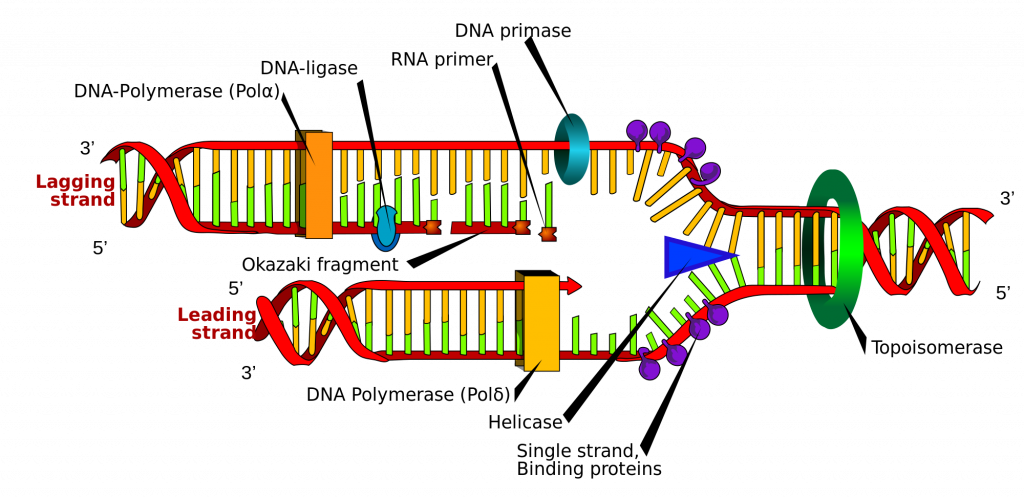DNA Replication
Today, I would like to talk about DNA replication in thousand meters bird’s eye view. There are a lot of invaluable resources regarding this topic. I just want to summarise the steps and main terminologies, as if taking some notes in order to refer later. Here are the steps for DNA-replication:
1. Replication Fork Formation (a.k.a Initiation)
This step can be seen as a preparation for the replication. Since DNA is in double stranded form, it must be “unzipped” first into two single strand in order to start replication. First thing first, the interactions between base pairs must be broken. This is performed by an enzyme called DNA helicase. This enzyme breaks the hydrogen bonding between base pairs to separate the strand into Y shaped known as replication fork.
DNA is directional in both strands, signified by a 5’ (pronounced as five prime) and 3’(pronounced as three prime) end. This directionality is important for replication as it only progresses in 5’ to 3’ direction. After replication fork, on strand is oriented in the 3’ to 5’ direction, leading strand, and the other strand is oriented from 5’ to 3’ direction, lagging strand. The two sides are therefore replicated with two diffirent processes to accomodate the directional diffirence.
2. Primer Binding
After DNA strands are separated, a short piece of RNA called a primer binds to the 3’ end of the strand. Primers are generated by the enzyme called DNA primase.
3. Elongation
Enzymes known as DNA polymerases are responsible creating new strand by a process called elongation. DNA polymerase adds pieces of DNA called Okazaki fragments to the strand between primers.
4. Termination
Once both new strands are formed, an enzyme called exonuclease removes all RNA primers from the original strands. These primers are then replaced with proper bases. Another enzyme called DNA ligase joins Okazaki fragments together forming a single unified strand. The ends of parent strands consists of repeated DNA sequences called telomeres. Telomeres act as protective caps. Another enzyme called telomerase catalyzes the synthesis of telomere sequences at the ends of the DNA.
Terminology Summary
As it can be seen, enzymes play a crucial role in DNA replication, lets summarise again their names and functionalities:
- DNA helicase: unwinds and separates double stranded DNA as it moves along the DNA. It forms the replication fork by breaking hydrogen bonds between nucleotide pairs in DNA.
- DNA primase: A type of RNA polymerase that generates RNA primers. Primers are short RNA molecules that act as templates for the starting point of DNA replication.
- DNA polymerases: Synthesize new DNA molecules by adding nucleotides to leading and lagging DNA strands.
- Topoisomerase or DNA Gyrase: Unwinds and rewinds DNA strands to prevent the DNA from becoming tangled or supercoiled.
- Exonucleases: Group of enzymes that remove nucleotide bases from the end of a DNA chain.
- DNA ligase: joins DNA fragments together by forming phosphodiester bonds between nucleotides.
All the steps with mentioned terminologies are show in the fascinating figure below.
 Image from https://teachmephysiology.com/biochemistry/cell-growth-death/dna-replication/
Image from https://teachmephysiology.com/biochemistry/cell-growth-death/dna-replication/
Resources:
- https://www.thoughtco.com/dna-replication-3981005